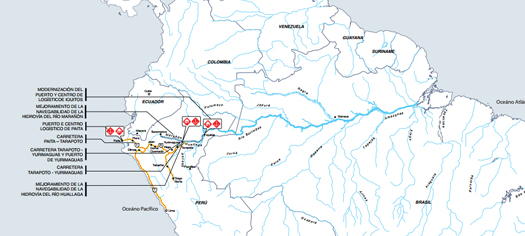
[Map of the IIRSA’s Amazonian axis, connecting the Pacific to the Atlantic across the Andes; from IIRSA document “8 Ejes de Integración de la Infraestructura de América del Sur”]
Keller Easterling, speculating about “a new counterintuitive economic model” of “infrastructural subtraction” in Domus last November:
“What are the points of leverage, trip distances or economies of scale that make air freight or rail profitable? Architects and urbanist are not themselves logisticians or inventors of new transportation technologies, but they can run the development scenarios demonstrating their spatial consequences. The license to develop may be expressed in terms of remote offsets like schools, technologies and improvements to community that recalibrate and shrink the need for roads. Roads might only exist when bundled with underground utilities, forest buffers, wireless telecommunication and other suppressors…
Just as architects are learning to look past single design events or objects, some of the most interesting scientists and economists in the world are learning to look past the rational assumptions of science to test ideas in a more complex context with multiple actors and circumstances. The soupy matrix of spatial protocols is a rich test bed for these new questions and for new extra-state agreements that pivot around seemingly irrational or changeable desires. In the Amazon and elsewhere, architects may be valuable precisely because they are not offering a hard science but rather an art of subtraction.”
This seems an extremely important space to define: if architects and landscape architects are interested, as Easterling suggests they should be, in developing the capacity to efficaciously alter or disturb the trajectory of organizational protocols which produce large-scale territorial effects like the two Easterling describes in the Domus article, Yasuni-ITT (in which the Ecuadorian government sells stakes in not developing oil resources within the Yasuní preserve) and the conflicting IIRSA (Initiative for the Integration of the Regional Infrastructure of South America, which aims to “integrate highway networks, river ways, hydroelectric dams and telecommunications links throughout the [South American] continent”), then we designers may need to demonstrate a peculiar utility that we offer — some set of intelligences or capacities innate or developable within the spatial design disciplines that make them useful to the design of such organizational protocols (hence, “valuable precisely because they are not offering a hard science but rather an art of subtraction”) — while simultaneously developing modes of practice and design tools that have the capacity to act on such protocols.
Easterling’s article has suggestions for the latter, as well, describing this “art of subtraction” as a new territory for design, “a perverse expertise” “tutored by the bad company [architects] keep”:
“Since architects know to how make the development machine lurch forward, might they not also know how to put it into reverse? Might they know how to design and incentivise not only the addition but also the subtraction of development?”
…
The puzzle of subtraction or negative development clearly turns on quotients of space, yet it might outwit the architect who applies only the customary approach to the familiar site, building or master plan. Global development conundrums like those in the Amazon perhaps tutor an approach to form-making that does not produce the single design event or object, but rather form in a register that the political world can more easily use.
While the remote controls of foreign developers or runaway market multipliers are the source of despair for many preservationists, they might also be a source of ingenious design by architects and urbanists who design counter-multipliers or counter-remotes. Exceeding the reach of single object form, a subtraction protocol might establish an interdependency of variables that addresses multiple sites over time — a cos X that acts as a valve or governor to suppress, leverage or offset development. Just as cos X is an expression for a stream of values, these active forms, unlike a master plan, might simply provide a delta for development concentration and contraction.”
Read the full article at Domus.

